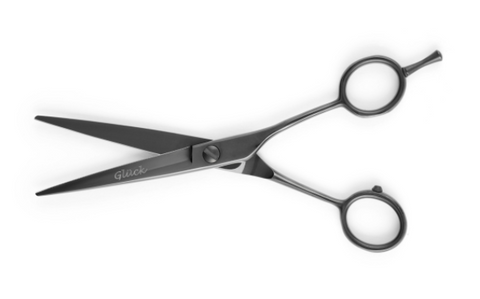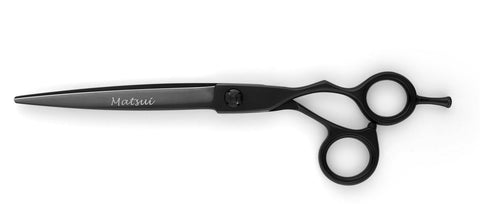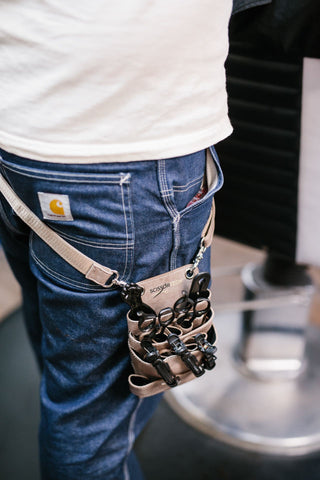Your Cart is Empty
⭐️ USE CODE "SANTA20" 20% STORE WIDE ⭐️ Don’t miss Christmas 🎄 Order by Dec 18
Good barber scissors you ask? Easy! But what's actually included in a good barber scissors is a whole other story! Unlike a premium hairdressing scissor, a barber scissor can include much more or different things to include in good barber shears. While some will argue 'but you can just use your normal hairdressing scissors' to use for barber scissors while others will argue 'no, you need a different pair for hairdressing and barbering' but who do you listen to? who is right?
Well, keep calm friends both above are right! You can use your hairdressing scissors or barber shears for barbering. Let's be real here hair cutting shears are well know to obviously cut hair no matter if they are entry level barber scissors used by barbers or professional hair shears used by professional hairdressers. This next part is where it may confuse you on which to choose, lucky for you, we're going to simplify exactly what you should be looking for in barber scissors if that is your chosen pair of scissors to use for barbering.

Much like standard hair cutting scissors, barber shearsneedto have high quality steel. Why? Because professional barber scissors and professional hair shears that have a high quality steel to them is what makes them stand out from any other scissors! The steel used for professional hair shears and professional barber shears are generally Japanese steel or German steel.
The Japanese stainless steel is the more commonly used steel amongst professional shears because of how strong it is in comparison to any other standard steel. Hitachi Cobalt stainless steel is fine example of Japanese steel that is often used for barber scissors. A quick break down of steel grading is below to help you better understand what is good and what isn't so good but still useable and needing to be included in good a barber scissor
The steel grade is very easily fooled by companies printing a higher grade symbol on the shears themselves so keeping an eye on the price tag is usually a good indication on whether to know if its genuine steel or not. For example some companies may be selling a 'high quality scissor' realllllly cheap - that right there is alarm bells and that company wanting to make a quick dollar out of you, if you fall for it then unfortunately your barber scissor wont last as long as the more expensive actual high quality steel. This being said you also shouldn't be ripped off - do your research before purchasing!

The blade edge is certainly a top feature to include because you get the wrong edge and it can really alter the way your cuts will turn out. Of course we state the obvious of needing a razor sharp edge but what more is there to an edge? Well let us tell you! There are 3 main types of edges including Convex edge, semi convex edge and of course a beveled edge. While yes, all barber scissors should have sharp blades, the type of blades will determine the type of cuts to be perform. So let's break the edges down further

A Convex edge blade is by far a more sharp edge than the other 2 edges. The convex edge isn't usually suggested for a novice but certainly a professional to handle an edge like this. This edge is extremely sharp convex blade which means its blade is so fine that a simple wrong move can slice away a chunk of hair, and if dropped it can be damage really easy! So we tend to suggest this edge is used your slide cutting, point cutting and of course feathering and certainly not any blunt cutting - because too much blunt cutting with this edge can dull the blades really quick.
The Semi convex edge blade is what we like to call the perfect mix of a beveled and convex edge. The reason why it's such a perfect mix is because the edge is neither too soft and delicate or or too harsh and abrasive but still ensuring it has sharp blades to it. The semi convex edge is a little more narrow than the beveled edge but not anything like a true convex edge either thus making it the perfect mix! Now of course you can use this edge like the convex edge blade, but you will have to make sure your sectioning isn't too thick as it will end up pulling on your clients hair, making it super uncomfortable for them.
The Beveled edge - the most common for barbers! The bevelled edge can have one or both edges with serration to it, which as we know grips the hair and helps stop it from sliding away or off the blade when cut. This type of edge is suitable for blunt cutting techniques which will get through those quick short back and sides/scissor over comb haircuts that. Which is why a barber is best suited for this type of edge.
The blade lengths for hair cutting scissors range anywhere from 4.5, 5, 5.5, 6, 6.5, 7, and 7.5inch. More commonly hairdressers tend to use anywhere from 4.5 to 6 inch for the more precision type of cutting. Where as barbers will use 6 to 7 inch. Why? Well, thats because when your perform a technique like scissor over comb, its much more efficient to get through the hair quicker by cutting hair with a longer blade length. Using a shorter blade will take more time as your not taking away as much has as a longer blade would, which is why barbers opt for a longer blade.
However it's not uncommon for barbers to use smaller bladed hair cutting scissors. A smaller hair cutting scissor will help get around ears or give a more precise and delicate hair cut, because as we know no two haircuts are the same! Which is why it's always a good idea to have 2 different sized scissors available.

The handle design is also a very important. You may think theres no much to a handle when it comes to hair cutting scissors, but in actual fact, the handle design you choose now could have an effect of your whole hairdressing/barbering career! The need to know - there are 4 main handle designs, and they include, Offset handle, Crane handle, Classic handle and of course the Swivel handle.
Rest assured, the finger holes in hair cutting scissors come pretty standard as a one size fits all (depending on the brand) and some finger holes will run larger and some smaller to suit everyones needs. But thats the least of your worries, let's dig a little deeper into the handle designs.
Offset handle scissors have one longer handle than the other, allowing you to lower your elbow and arm while cutting most styles.
The Pros: When you're cutting all day, you'll want scissors that will keep up and keep your hands in a comfortable and neutral position. With the offset handle (also referred to as semi-offset), your thumb travels a shorter distance which lightens the stress on the thumb tendon.
The Cons: The short thumb handle and a more extended finger handle require you to cut with a raised elbow for some styling techniques.

Known as straight or Classic handles, opposing handle scissors were the only options available for the longest time. And they remain a popular choice for barbers and stylists alike, even today.
The Pros: This type of handle is excellent for cuts that don't take too much time.
The Cons: Extended use of scissors with opposing handles can lead to a light strain on your wrist, elbow, and shoulder. And left unchecked, you will likely experience symptoms associated with carpal tunnel syndrome.

Similar to the offset scissors, crane handles have a bottom ring that pushes further away from the top ring. However, what makes it different is the angle of the handle when you hold the blades of a crane shear horizontally. The crane will angle downward, not right across in a straight line. Additionally, the thumb handle is shorter than other handles.
The Pros: The biggest pro is that the crane handle mimics the hand's normal alignment reducing the potential strain on your wrist, elbow, and shoulder when cutting. The ergonomic design allows your muscles to relax while you cut hair.
The Cons: None really. They're great for anyone concerned about potential RSI (repetitive strain injury).

Swivel shears feature a spinning or swivelling thumbhole that allows you to freely adjust the position of your fingers, wrist, elbow, and shoulder, reducing the risk of repetitive use injuries.
The Pros: This handle is a go-to ergonomic choice for many professionals. That’s because the swivel thumb handles allow you to keep your elbow and shoulder down, easing the strain and stress you would feel on your body. And since your wrist maintains a neutral position, you'll be able to alleviate the strain related to repetitive strain injuries or carpal tunnel syndrome.
The Cons: To fully embrace the ergonomic benefits of swivel handles, there's a slight learning curve.

Of course where would we be without the additional accessories of a good barber shear? Well as long as we're on the subject the additional accessories that should be included is:
Finger inserts, along with extra insert, to be able to either remove or insert so the finger hole is comfortable to be using.
Whether its a removable finger rest, or a secured finger rest all shears should come with it to make holding your shear comfortable.
This isn't really an additional but simply a must. All scissors NEED a tension screw to maintain the tension of their shears.

Lastly - thinning scissors and even texturising scissors are a great addition to your barbering scissors to help create the perfect haircuts.

So now we know the in's and out's of what is including is a barbering scissor, hopefully it will help you on your way to choosing the perfect pair of scissors for your barbering career. If however you're still a little stuck - reach out to us and our supportive and friendly customer service team will surely help you out.